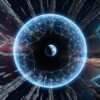In the modern age, our lives are a whirlwind of information, obligations, and digital noise. From the moment we wake, we are bombarded with headlines, notifications, and demands. We chase innovation, pursue progress, and celebrate technological achievement—yet many of us remain strangers to ourselves. The deeper questions—”Who am I?”, “What is real?”, “Why do I suffer?”—are drowned out by the surface static of life.
And yet, thousands of years ago, in the stillness of ancient India, sages posed these very questions. Their answers didn’t come in the form of doctrine or dogma. Instead, they emerged in poetic, mysterious texts known as the Upanishads—a collection of spiritual teachings so powerful that they continue to reverberate through the ages.
The Upanishads are not merely books. They are not scriptures in the conventional sense. They are gateways to inner revolution—texts that invite not blind belief, but direct realization. They do not ask you to follow; they challenge you to awaken. In a world where everything pulls you outward, the Upanishads pull you inward—toward the core of your being, toward the eternal truth you’ve always carried within.
What Are the Upanishads?
The word Upanishad literally means “sitting down near”—evoking the image of a student sitting humbly at the feet of a teacher. These texts are the philosophical heart of the Vedas, the oldest sacred scriptures of India. They form the concluding section of the Vedas and are thus known as Vedanta, which means “the end of the Vedas.” But this is not an “end” in the sense of finality—it is the point of culmination, the turning inward from ritual to realization.
The Upanishads are dialogues—between masters and disciples, between gods and mortals, between the questioning mind and the awakened self. They are metaphysical poetry and spiritual philosophy. They challenge us to look beyond what we see, what we think, and what we believe we are.

They are not religious in the dogmatic sense. They are not about belief systems or commandments. They are explorations of consciousness, existence, and liberation. They are mirrors in which we see not the world, but our deepest, most unchanging Self.
Historical Roots: A Dawn of Global Awakening
The earliest Upanishads, such as the Brihadaranyaka and the Chandogya, were composed between the 8th and 2nd centuries BCE—a time of profound spiritual awakening not just in India, but across the world. This was the same era that witnessed the rise of Buddha in India, Lao Tzu and Confucius in China, and the pre-Socratic philosophers in ancient Greece.
This period, often called the Axial Age, marked a pivotal shift in human consciousness. For the first time in recorded history, humanity turned inward to ask: What is the nature of existence? What lies beyond death? Who am I, beyond this body and mind?

The Upanishads are the Indian response to these eternal questions. They are not theoretical or abstract. They are born from deep meditative realization, from lives lived in silence and stillness, from consciousness stripped bare of ego and illusion.
Core Teachings: The Fire at the Heart of the Upanishads
Brahman: The Absolute Reality
Brahman is not “God” in a religious sense. It is not a person or a deity. It is the boundless, formless, infinite essence of all that is. It is pure being, pure consciousness, pure bliss. Brahman is what exists when all names and forms fall away. It is the thread running through every atom, every thought, every breath.
Brahman is not something we believe in; it is something we are. It is not outside us—it is us.
Atman: The Inner Self
Atman is the Self—not the ego, not the personality, not even the soul as popularly imagined. Atman is the unchanging awareness behind every thought and emotion. It is the eternal witness, the silent observer that was there before you were born and will remain when the body dissolves.
The stunning revelation of the Upanishads is this: Atman is Brahman. The deepest truth of your being is not separate from the ultimate reality of the cosmos.
This is not metaphor—it is the core of non-dual realization. There is no separation. The divine is not “out there”—it is the very ground of your being.
Maya: The Veil of Illusion
Why don’t we see this truth? Why do we feel separate, anxious, and lost?
Because of Maya—the power of illusion. Maya is the dreamlike reality we mistake for truth. It is the veil that convinces us that we are the body, that life is a sequence of problems, that death is an end.
Maya is not evil—it is part of the play of consciousness. But to awaken, we must see through it. We must stop identifying with the fleeting and remember the eternal.
As one Upanishad says: “The world is like a dream. Truth is waking up.”
Moksha: Liberation
The goal is Moksha—not heaven, not reward, but liberation. Moksha is the end of false identification. It is the freedom that arises when we realize we are not the limited self but the infinite consciousness.
Moksha is not attained through rituals, wealth, or power. It is not granted by any god. It is revealed when illusion falls away, and the Self sees itself clearly, like a mirror wiped clean of dust.
The Path to Awakening: How the Upanishads Transform Us
The Upanishads are not manuals—they are maps. They don’t give instructions; they offer insight. Their power lies not in what they say, but in what they awaken in us.
Jnana Yoga: The Path of Knowledge
This is the razor-sharp path of inquiry. It asks us to question everything we think we are. “Who am I, if I am not the body, not the mind, not my past?” Through persistent contemplation and analysis, the illusions begin to fall away, revealing the Self behind all appearances.
Nididhyasana: Deep Meditation
Upanishadic meditation is not about controlling the mind or visualizing gods. It is about pure awareness—becoming the witness to all that arises without clinging or judgment. It is the art of being, not doing. Through this silence, truth emerges—not as belief, but as direct knowing.
Turning Inward: Beyond Ritual
The Upanishads warn against empty ritualism. Truth cannot be found in ceremonies or external actions alone. Liberation comes only through direct inner experience. The outer world is a shadow. The real journey is inward.
The way home
In our age of anxiety, distraction, and spiritual confusion, the Upanishads offer something radical and essential: the way home.
They do not ask you to convert, to worship, or to adopt a new identity. They ask only that you look. That you turn your gaze inward and see what has always been there—the radiant, formless Self, untouched by time or trauma.
The Upanishads are not an escape from the world; they are a return to what is real. They strip away the false and reveal the sacred in the ordinary. They show us that we are not broken, not lost, not alone. We are That—pure, whole, infinite.
And so, if you feel weary of the noise, the restlessness, the endless chase for meaning in things that never satisfy—then pause. Breathe. Listen.
The truth is not out there.
It is you.
An Invitation, Not a Conclusion
The Upanishads are not finished. They are alive—living fires that ignite insight in those ready to listen. They do not offer quick answers or easy comfort. But they offer something far greater: awakening.
If you’re ready to go beyond the surface, beyond the chatter of the mind, and into the stillness where truth waits—then the Upanishads are waiting for you.
You do not need to become anything. You only need to remember what you already are.

















